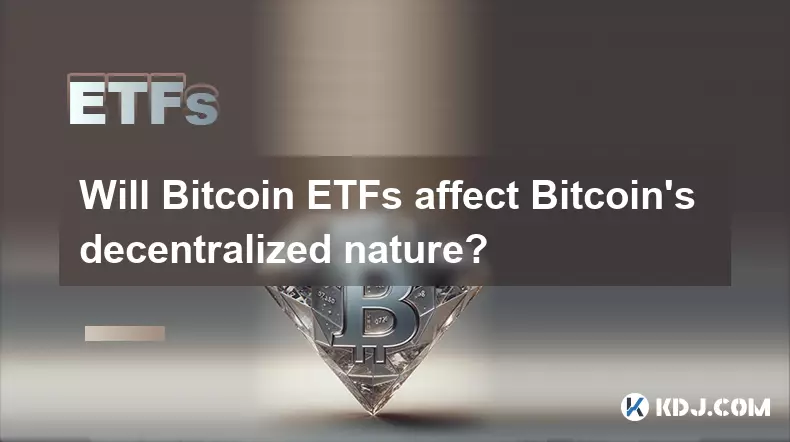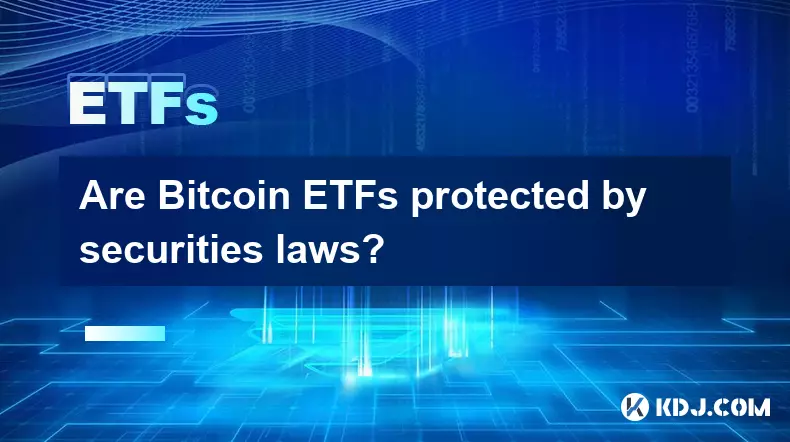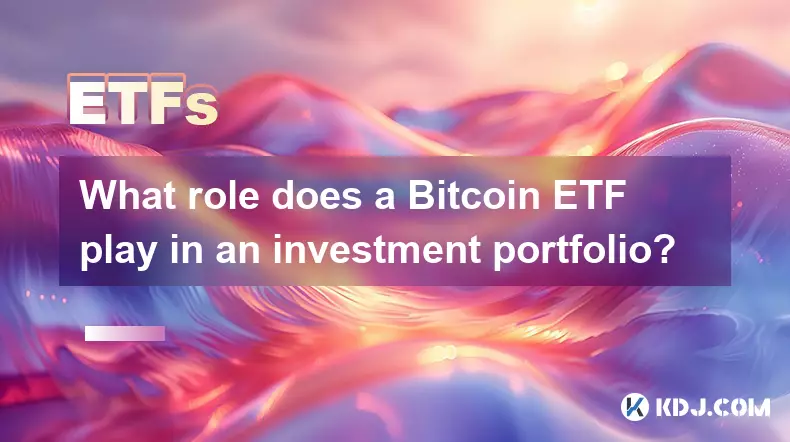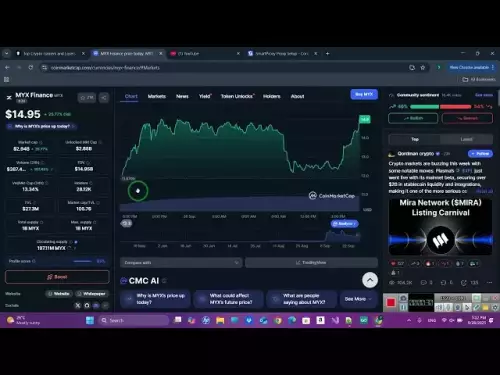-
 bitcoin
bitcoin $109547.008142 USD
0.04% -
 ethereum
ethereum $4011.838726 USD
-0.05% -
 tether
tether $1.000402 USD
-0.01% -
 xrp
xrp $2.798606 USD
0.88% -
 bnb
bnb $970.877944 USD
1.39% -
 solana
solana $202.237275 USD
-0.95% -
 usd-coin
usd-coin $0.999673 USD
0.00% -
 dogecoin
dogecoin $0.229294 USD
-1.15% -
 tron
tron $0.336370 USD
-0.45% -
 cardano
cardano $0.777260 USD
-1.66% -
 hyperliquid
hyperliquid $45.503019 USD
1.73% -
 ethena-usde
ethena-usde $1.000362 USD
0.01% -
 chainlink
chainlink $20.785303 USD
-1.10% -
 avalanche
avalanche $28.755822 USD
-0.11% -
 stellar
stellar $0.358303 USD
-0.48%
Is the volatility of Bitcoin ETFs consistent with Bitcoin?
Bitcoin ETFs generally track spot prices closely, but structural differences like trading hours, liquidity, and market access can cause temporary premiums, discounts, or dampened volatility.
Sep 26, 2025 at 01:18 am

Bitcoin ETFs and Their Relationship to Bitcoin Price Movements
1. Bitcoin ETFs are financial instruments designed to mirror the price of Bitcoin without requiring investors to directly hold the cryptocurrency. These funds trade on traditional stock exchanges, offering accessibility to institutional and retail investors who prefer regulated markets. The underlying premise is that the ETF’s net asset value should closely follow the spot price of Bitcoin.
2. Despite this design goal, discrepancies can emerge due to structural differences between the crypto market and traditional financial systems. Trading hours differ significantly—Bitcoin trades 24/7 across global exchanges, while most ETFs are limited to standard market hours. This mismatch can lead to delayed reactions in ETF pricing when major Bitcoin price shifts occur outside regular trading windows.
3. Premiums or discounts to net asset value often appear during periods of high volatility. If demand for the ETF surges after markets close, the next day’s opening price may reflect a premium over the actual Bitcoin value at that time. Conversely, panic selling during off-hours might result in a discount when trading resumes.
4. Market sentiment also plays a role in diverging behavior. Investor perception of regulatory risks, macroeconomic data, or geopolitical events can influence ETF flows independently of Bitcoin’s immediate price action. For example, positive news about SEC approvals could boost ETF inflows even if Bitcoin itself remains flat.
5. Authorized participants responsible for creating and redeeming ETF shares help maintain alignment through arbitrage mechanisms. When an ETF trades above its NAV, these entities create new shares to capture the spread, increasing supply and pushing the price down. However, inefficiencies in this process—especially during extreme volatility—can allow temporary deviations to persist.
Volatility Patterns: ETF vs. Spot Bitcoin
1. In theory, a well-functioning Bitcoin ETF should exhibit similar volatility levels as the underlying asset. Historical data from approved ETFs in the U.S. shows a strong correlation in daily price changes, especially during normal market conditions. The beta coefficient between ETF returns and Bitcoin spot returns typically remains close to one.
2. During flash crashes or sudden rallies, however, ETFs may show dampened volatility. This occurs because exchange circuit breakers and liquidity constraints limit how quickly prices can adjust. A sharp drop in Bitcoin over five minutes might take an hour or more to fully reflect in ETF pricing due to order book depth and risk management protocols.
3. Liquidity providers play a critical role in smoothing intraday fluctuations. High-frequency traders and market makers use futures, options, and spot positions to hedge ETF exposure, which helps stabilize premiums but does not eliminate short-term divergence.4. Differences in investor base contribute to behavioral divergence. ETF holders tend to be longer-term or risk-averse compared to active crypto traders. As a result, ETF volume spikes often lag behind those seen on Binance or Coinbase, leading to less responsive price discovery during fast-moving events.
5. Regulatory reporting requirements add another layer of friction. Large transactions in ETFs must be disclosed, potentially influencing timing decisions by institutions. In contrast, over-the-counter Bitcoin trades can occur privately and instantaneously, allowing quicker capital allocation in volatile environments.
Impact of Market Structure on Price Alignment
1. Custody arrangements affect perceived risk and, consequently, ETF valuation. While Bitcoin is held in cold storage by custodians like Coinbase or BitGo, concerns about insurance coverage or access controls can create minor valuation gaps. Investors may assign a slight risk discount even if no breach has occurred.
2. Tax treatment influences holding patterns. Capital gains rules for ETFs differ from those applied to direct crypto holdings, affecting investor behavior. Some participants may avoid selling during downturns to defer taxes, reducing turnover and amplifying stale pricing effects.
3. Futures-based ETFs introduce additional complexity. Unlike spot ETFs tied directly to Bitcoin’s price, futures contracts carry roll costs and contango effects. These structural elements decouple performance over time, making volatility profiles less consistent with the underlying asset.4. Geopolitical factors impact ETF accessibility. Sanctions, brokerage restrictions, or regional regulations can limit participation in certain jurisdictions, narrowing the pool of arbitrageurs. Reduced competition among market makers widens bid-ask spreads and increases deviation risk.
5. Settlement delays in traditional finance systems prolong reconciliation cycles. While blockchain transactions settle in minutes, ETF creations and redemptions may take days due to intermediary processing. This operational latency weakens real-time price linkage.
Frequently Asked Questions
What causes Bitcoin ETFs to trade at a premium or discount?Discrepancies arise from differences in trading hours, investor demand imbalances, and delays in share creation. When Bitcoin moves sharply after markets close, the ETF cannot adjust until reopening, creating a gap that manifests as a premium or discount.
Do all Bitcoin ETFs track the price equally well?No. Spot ETFs generally have tighter tracking error than futures-based products. Regulatory approval, custody quality, and issuer reputation also influence accuracy. Funds with larger assets under management typically experience better liquidity and lower slippage.
How do market makers support ETF price stability?They continuously quote buy and sell prices, using hedging strategies involving Bitcoin futures and spot positions. By absorbing short-term imbalances, they reduce volatility spillover and maintain proximity to the net asset value.
Can ETF outflows signal a bearish trend for Bitcoin?Sustained outflows may reflect weakening confidence among institutional investors, often preceding broader market declines. However, localized redemption events do not always correlate with spot price movements, especially if offset by new inflows elsewhere.
Disclaimer:info@kdj.com
The information provided is not trading advice. kdj.com does not assume any responsibility for any investments made based on the information provided in this article. Cryptocurrencies are highly volatile and it is highly recommended that you invest with caution after thorough research!
If you believe that the content used on this website infringes your copyright, please contact us immediately (info@kdj.com) and we will delete it promptly.
- BlockchainFX, Binance Coin, Cardano: Decoding the Crypto Landscape in 2025
- 2025-09-29 04:45:12
- Cathie Wood, Bitcoin, and the Future of Monetary Standards: A New York Perspective
- 2025-09-29 04:25:17
- Crypto Presales Under the Microscope: BlockDAG, HYPER, and the Hunt for the Next Big Thing
- 2025-09-29 04:25:17
- Ethereum Bulls Eye $4,000: Is the Rally Sustainable?
- 2025-09-29 05:05:14
- Aster Price Surge: Bullish Breakout or Falling Wedge Fiasco?
- 2025-09-29 04:45:12
- Aptos Price Prediction: Will the Velociraptor Upgrade Trigger a Rally?
- 2025-09-29 04:50:01
Related knowledge

Will Bitcoin ETFs affect Bitcoin's decentralized nature?
Sep 24,2025 at 02:00am
Impact of Bitcoin ETFs on Market Accessibility1. Bitcoin ETFs have significantly lowered the barrier to entry for traditional investors who may not be...

Which exchanges list Bitcoin ETFs?
Sep 26,2025 at 03:18am
Major Cryptocurrency Exchanges Offering Bitcoin ETFs1. The landscape of digital asset trading has evolved significantly with the introduction of Bitco...

Are Bitcoin ETFs protected by securities laws?
Sep 28,2025 at 03:00am
Regulatory Framework Surrounding Bitcoin ETFs1. Bitcoin ETFs operate within the boundaries of established securities regulations, primarily under the ...

What role does a Bitcoin ETF play in an investment portfolio?
Sep 27,2025 at 12:36am
Understanding the Function of a Bitcoin ETF in Portfolio Diversification1. A Bitcoin ETF allows traditional investors to gain exposure to cryptocurren...

Is the volatility of Bitcoin ETFs consistent with Bitcoin?
Sep 26,2025 at 01:18am
Bitcoin ETFs and Their Relationship to Bitcoin Price Movements1. Bitcoin ETFs are financial instruments designed to mirror the price of Bitcoin withou...

Do Bitcoin ETFs support leveraged or inverse investing?
Sep 29,2025 at 03:18am
Understanding Bitcoin ETFs and Their Investment Structures1. Bitcoin ETFs, or exchange-traded funds, are investment vehicles that track the price of B...

Will Bitcoin ETFs affect Bitcoin's decentralized nature?
Sep 24,2025 at 02:00am
Impact of Bitcoin ETFs on Market Accessibility1. Bitcoin ETFs have significantly lowered the barrier to entry for traditional investors who may not be...

Which exchanges list Bitcoin ETFs?
Sep 26,2025 at 03:18am
Major Cryptocurrency Exchanges Offering Bitcoin ETFs1. The landscape of digital asset trading has evolved significantly with the introduction of Bitco...

Are Bitcoin ETFs protected by securities laws?
Sep 28,2025 at 03:00am
Regulatory Framework Surrounding Bitcoin ETFs1. Bitcoin ETFs operate within the boundaries of established securities regulations, primarily under the ...

What role does a Bitcoin ETF play in an investment portfolio?
Sep 27,2025 at 12:36am
Understanding the Function of a Bitcoin ETF in Portfolio Diversification1. A Bitcoin ETF allows traditional investors to gain exposure to cryptocurren...

Is the volatility of Bitcoin ETFs consistent with Bitcoin?
Sep 26,2025 at 01:18am
Bitcoin ETFs and Their Relationship to Bitcoin Price Movements1. Bitcoin ETFs are financial instruments designed to mirror the price of Bitcoin withou...

Do Bitcoin ETFs support leveraged or inverse investing?
Sep 29,2025 at 03:18am
Understanding Bitcoin ETFs and Their Investment Structures1. Bitcoin ETFs, or exchange-traded funds, are investment vehicles that track the price of B...
See all articles









































































